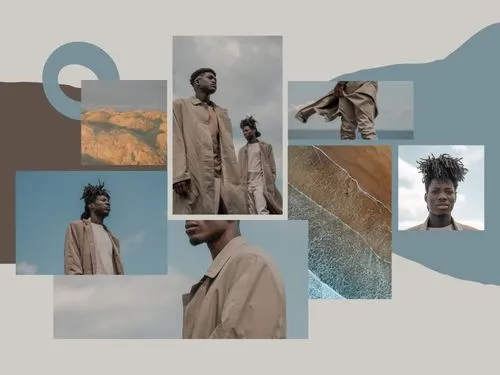In 2025, sustainable menswear has moved from niche to mainstream, reshaping men’s wardrobes with eco-conscious designs. Brands now prioritize recycled materials, ethical production, and longevity, reflecting a shift in consumer values. With climate concerns rising, sustainability goes beyond reducing harm—it drives innovation in fabrics and transparency in supply chains. This guide explores the materials, brands, and steps to building a stylish, sustainable wardrobe.
La urgencia de la moda masculina sostenible en 2025
La moda sigue siendo una de las industrias más contaminantes del mundo, responsable de aproximadamente el 10 % de las emisiones globales de carbono y de enormes cantidades de desperdicio de agua, según informes ambientales actualizados de 2025. Para los hombres, que suelen buscar la practicidad y la durabilidad en sus elecciones de ropa, la transición hacia la sostenibilidad ofrece la combinación perfecta: prendas atemporales que duran más, consumen menos recursos y reflejan una creciente ética de responsabilidad. En 2025, este cambio está impulsado por la presión del consumidor, la innovación tecnológica y una nueva ola de marcas que redefinen el significado de vestir bien.
El armario del hombre moderno en 2025 no está repleto de compras impulsivas de moda rápida. En cambio, se trata de una colección seleccionada de prendas versátiles y de alta calidad, confeccionadas con materiales que minimizan el daño ambiental y promueven prácticas laborales éticas. Ya sea una chaqueta de cáñamo para las mañanas frías, una camiseta de algodón orgánico para uso diario o una parka de poliéster reciclado para aventuras al aire libre, la sustentabilidad es ahora una piedra angular del estilo.
Materiales Ecológicos Revolucionando la Moda Masculina
La base de cualquier armario sostenible son los materiales con los que está confeccionado. En 2025, los tejidos ecológicos han superado lo básico, combinando rendimiento, comodidad y beneficios ambientales.
A continuación, analizamos en detalle los materiales más destacados que impulsan esta revolución:
- Algodón orgánico: La producción convencional de algodón consume muchos recursos, consume mucha agua y rocía los campos con pesticidas. El algodón orgánico cambia las reglas del juego, ya que se cultiva sin químicos sintéticos y utiliza un 71 % menos de agua, según datos de Textile Exchange para 2025. Para los hombres, es la prenda predilecta para camisetas suaves, camisas de botones e incluso vaqueros. Su durabilidad garantiza que estas prendas se mantengan en rotación durante años, no meses.
- Cáñamo: Conocido como una “superfibra”, el cáñamo es un campeón de la sostenibilidad. Crece rápidamente, a veces en tan solo 100 días, requiere poca agua y prospera sin pesticidas. En 2025, su textura rugosa lo hace ideal para pantalones, chaquetas y camisas informales. Además, es naturalmente antimicrobiano, lo que significa menos lavados y una mayor vida útil.
- Poliéster reciclado: Derivado de botellas de plástico posconsumo o textiles desechados, el poliéster reciclado reduce los residuos en vertederos y el consumo de energía hasta en un 59 % en comparación con el poliéster virgen, según estudios del sector realizados en 2025. Es un material predilecto para ropa deportiva, chaquetas de forro polar y prendas impermeables de abrigo, ofreciendo el mismo rendimiento con una huella de carbono mucho menor.
- TENCEL Lyocell: Esta fibra biodegradable, hecha de pulpa de madera de eucalipto o haya de origen sostenible, se produce mediante un sistema de circuito cerrado que recicla el 99 % del agua y los disolventes. Suave, transpirable y ligero, el TENCEL es perfecto para camisas, polos e incluso ropa interior, combinando ecocertificaciones con comodidad durante todo el día.
- Cuero de Hongo (Micelio): Una de las innovaciones más destacadas de 2025, el cuero de hongo se cultiva a partir de raíces fúngicas en un laboratorio, con un mínimo de tierra y agua. Es biodegradable y duradero, e imita el aspecto del cuero tradicional: carteras, cinturones e incluso zapatillas minimalistas. Las marcas están aumentando la producción, haciéndolo más accesible este año.
- Textiles a Base de Algas: Las algas, un recurso renovable, se hilan en hilos y se mezclan con otras fibras para crear tejidos ligeros y con huella de carbono negativa. En 2025, prepárense para ver calcetines, capas base y camisetas informales con infusión de algas que secuestran activamente el CO2 durante su producción.
- Seda cultivada en laboratorio: La producción tradicional de seda se basa en gusanos de seda, pero las alternativas cultivadas en laboratorio utilizan la bioingeniería para replicar la lujosa textura de la seda sin la intervención de animales ni un alto consumo de agua. Está apareciendo en camisas de vestir y corbatas, ofreciendo una opción libre de crueldad animal y de bajo impacto para la ropa formal.
Estos materiales no son solo palabras de moda, sino opciones prácticas que equilibran estilo, funcionalidad y sostenibilidad. Los hombres pueden reducir su impacto ambiental eligiendo prendas hechas de ellos sin sacrificar la calidad ni la estética.
Marcas que lideran la moda masculina ética
En 2025, las marcas a la vanguardia de la moda masculina sostenible no solo incorporarán etiquetas “ecológicas” a sus productos, sino que también repensarán cada paso del proceso, desde el abastecimiento hasta las soluciones para el final de su vida útil. Estos son los pioneros que marcan la pauta:
- Patagonia: Líder incansable, Patagonia continúa innovando en 2025 con el uso de poliéster reciclado, algodón orgánico y cáñamo en toda su resistente línea de ropa masculina, como jerseys de forro polar, chaquetas aislantes y pantalones duraderos. Sus fábricas con certificación de Comercio Justo garantizan que los trabajadores reciban salarios dignos, mientras que su programa Worn Wear fomenta las reparaciones y el reciclaje. El objetivo de Patagonia de alcanzar la neutralidad de carbono para 2025 subraya su compromiso con el cambio sistémico.
- Outerknown: Fundada por la surfista profesional Kelly Slater, Outerknown fusiona un estilo relajado con la sostenibilidad. Su colección 2025 incluye camisetas de algodón orgánico, pantalones cortos de mezcla de cáñamo y bañadores ECONYL (fabricados con redes de pesca abandonadas, similares al nailon regenerado). Producido en instalaciones con certificación de Comercio Justo, Outerknown demuestra que lo ecológico puede ser sinónimo de estilo sin esfuerzo.
- Kotn: Esta marca con certificación B Corp se especializa en prendas básicas minimalistas (camisetas, camisetas henley y pantalones chinos) confeccionadas con algodón orgánico egipcio de pequeños agricultores. Su cadena de suministro transparente y su compromiso para 2025 de financiar iniciativas educativas en comunidades agrícolas la convierten en una opción destacada para consumidores conscientes.
- Taylor Stitch: Centrada en la producción en lotes pequeños, Taylor Stitch reduce los residuos a la vez que ofrece prendas atemporales como vaqueros con orillo y franela de algodón orgánico. Su programa Restitch, ampliado en 2025, recupera artículos usados para su reventa o reciclaje, evitando que la ropa acabe en los vertederos.
- Tentree: Conocida por su misión de plantar árboles (más de 100 millones de árboles para 2025), Tentree ofrece ropa para actividades al aire libre hecha de cáñamo, poliéster reciclado y algodón orgánico. Desde sudaderas con capucha hasta pantalones deportivos, cada compra financia la reforestación, combinando el estilo personal con el bien del planeta.
- Quince: El lujo asequible se une a la sostenibilidad en Quince, donde camisetas de algodón orgánico, chaquetas de poliéster reciclado y suéteres de cachemira de origen responsable están disponibles a precios directos al consumidor. Al eliminar intermediarios y adherirse a estándares laborales justos, Quince hará accesible la moda ética en 2025.
- Toad & Co: Esta marca apuesta por tejidos ecológicos como TENCEL Lyocell, cáñamo y mezclas recicladas para prendas versátiles: camisas de franela, chaquetas ligeras e incluso pijamas sostenibles. Sus iniciativas para 2025 incluyen un impulso a los envases 100 % biodegradables, lo que refuerza su filosofía ecológica.
- Asket: Una marca sueca con la filosofía de “menos es más”, Asket crea colecciones permanentes (sin rotación estacional) con algodón orgánico, lana reciclada y materiales trazables. Su herramienta de transparencia para 2025 te permite rastrear el recorrido de cada prenda, desde la materia prima hasta tu armario.
- Allbirds: Conocida por su calzado, Allbirds amplió su línea de ropa en 2025 con camisetas y chaquetas confeccionadas con TENCEL, algodón orgánico y poliéster reciclado. Su cadena de suministro neutra en carbono y su calzado de caucho natural son referentes en diseño ecoconsciente.
- Everlane: Sus básicos limpios y modernos, como chaquetas bomber, camisetas de cuello redondo y vaqueros, se basan en algodón orgánico y tejidos reciclados. Su compromiso de 2025 “Sin Plástico Nuevo” garantiza el reciclaje de todos los materiales sintéticos, junto con el compromiso de ofrecer salarios justos en toda su cadena de suministro.
These brands aren’t just selling clothes; they’re offering an accountable and forward-thinking vision of fashion. Certifications like GOTS, Fair Trade, and B Corp signal their credibility, while initiatives like take-back programs and carbon offsets amplify their impact.
Creando tu armario sostenible en 2025
¿Cómo puedes convertir esto en un armario que te funcione? Empieza con la intención. Aquí tienes una guía paso a paso para crear un armario sostenible en 2025:
- Revisa tu guardarropa actual: Haz un inventario de lo que tienes. Identifica las prendas que te encantan y usas a menudo; esas son las que te quedan. Dona o recicla el resto a través de programas como Worn Wear de Patagonia o iniciativas textiles locales.
- Invierte en básicos: Crea con prendas esenciales versátiles y ecológicas:
- Camiseta de algodón orgánico: Una camiseta Kotn o Quince en tonos neutros combina con todo. Chaqueta de cáñamo: Outerknown o Tentree ofrecen opciones duraderas y elegantes.
- Ropa deportiva de poliéster reciclado: El forro polar de Patagonia o las zapatillas de running de Allbirds te mantienen en movimiento de forma sostenible.
- Vaqueros de fabricación ética: El denim orillo de Taylor Stitch o los vaqueros de algodón orgánico de Everlane envejecen de maravilla.
- Prioriza la calidad sobre la cantidad: Una sola chaqueta bien hecha es mejor que tres baratas que se deshacen. Busca costuras dobles, fibras naturales y marcas con programas de reparación.
- Compra de segunda mano: Plataformas como Poshmark, thredUP o tiendas de segunda mano locales prolongan la vida útil de la ropa. Una chaqueta de cuero vintage o un forro polar Patagonia de segunda mano añaden personalidad y reducen el desperdicio.
- Cuidado inteligente: Lava menos, usa agua fría y seca al aire para prolongar la vida útil de la prenda. Las prendas de cáñamo y TENCEL, en particular, requieren un mantenimiento mínimo.
- Investiga marcas: Comprueba las certificaciones (GOTS, OEKO-TEX) y supervisa la transparencia de la cadena de suministro. El sitio web de una marca o su informe de sostenibilidad de 2025 pueden revelar mucha información.
- Apuesta por la innovación: Prueba un cinturón de cuero de champiñón o unos calcetines con mezcla de algas. Estos materiales de vanguardia son tema de conversación y contribuyen a la protección del planeta.
En 2025, un armario sostenible no se trata de perfección, sino de progreso. Empieza con algo pequeño, como cambiar camisetas de moda rápida por algodón orgánico, y construye a partir de ahí. El objetivo es la longevidad: ropa que perdure en el tiempo: temporadas, tendencias y usos.
El panorama general: Por qué es importante
Más allá del estilo personal, elegir ropa masculina sostenible en 2025 tiene un impacto positivo. Apoya a los agricultores que cultivan algodón orgánico, reduce los 92 millones de toneladas de residuos textiles que llegan a los vertederos anualmente (según estimaciones para 2025) y presiona a la industria para que reconsidere sus prácticas. Históricamente, la moda masculina ha quedado rezagada respecto a la femenina en sostenibilidad, pero este año marca un punto de inflexión. Las marcas están escuchando, los consumidores están influyendo en su bolsillo y las innovaciones están creciendo.
Tomemos como ejemplo el impulso a la neutralidad de carbono de Patagonia o el hito de reforestación de Tentree: no son solo estrategias de marketing, sino pasos medibles hacia un planeta más saludable. Formas parte de ese cambio al alinear tu vestuario con estos valores. Además, te da la tranquilidad de saber que tu ropa cuenta una historia con propósito, no solo moda.
El futuro de la moda masculina sostenible
En 2025, esperamos más avances: materiales biofabricados como el algodón cultivado en laboratorio, zapatos impresos en 3D con cero residuos y cadenas de suministro impulsadas por IA que optimizan la sostenibilidad. Las marcas apostarán más por la circularidad, diseñando prendas que puedan rehacerse o compostarse al final de su vida útil. Para los hombres, esto significa armarios que no solo sean ecológicos, sino también a prueba de futuro.
¿Cuál es tu próximo paso? Quizás una chaqueta de cáñamo de Outerknown, un forro polar Patagonia reparado o una joya de segunda mano. Sea como sea, 2025 es tu año para vestir con propósito, porque la moda sostenible no es una tendencia; es el nuevo estándar.







